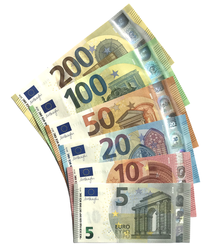
Back عملات اليورو الورقية Arabic Billetes d'euru AST Eurobankovky Czech Eurosedler Danish Eurobanknoten German Τραπεζογραμμάτια ευρώ Greek Eŭro-bankbiletoj Esperanto Billetes de euro Spanish Euro rahatähed Estonian Eurosetelit Finnish


Both series are legal tender in the eurozone.
Banknotes of the euro, the common currency of the eurozone (euro area members), have been in circulation since the first series (also called ES1) was issued in 2002. They are issued by the national central banks of the Eurosystem or the European Central Bank.[1] The euro was established in 1999, but "for the first three years it was an invisible currency, used for accounting purposes only, e.g. in electronic payments".[2] In 2002, notes and coins began to circulate. The euro rapidly took over from the former national currencies and slowly expanded around the European Union.
Denominations of the notes range from €5 to €500 and, unlike euro coins, the design is identical across the whole of the eurozone, although they are issued and printed in various member states. The euro banknotes are pure cotton fibre, which improves their durability as well as giving the banknotes a distinctive feel. They have a variety of color schemes and measure from 120 by 62 millimetres (4.7 in × 2.4 in) to 160 by 82 millimetres (6.3 in × 3.2 in) (first series) and from 120 by 62 millimetres (4.7 in × 2.4 in) to 153 by 77 millimetres (6.0 in × 3.0 in) (second series). The euro notes contain many complex security features such as watermarks, invisible ink characteristics, holograms, optically variable inks and microprinting that document their authenticity. While euro coins have a national side indicating the country of issue (although not necessarily of minting), euro notes lack this. Instead, this information is shown by the first character of each note's serial number.
According to European Central Bank estimates, in July 2023, there were about 29.624 billion banknotes in circulation around the eurozone, with a total value of about €1.569 trillion.[3] On 8 November 2012, the ECB announced that the first series of notes would be replaced by the Europa series (also called ES2), starting with the 5 euro note.[4] This series does not have a €500 note, as the ECB have decided to permanently cease its production over concerns that it could facilitate illicit activities.[5]
Estimates suggest that the average life of a euro banknote is about three years before replacement due to wear, but with a wide variation by denomination level, from less than a year for €5 banknotes to over 30 years for €500 banknotes, on average. High denomination banknotes (€100, €200, €500) typically last longer as they are less frequently used. The Europa series lower denomination €5 and €10 banknotes are designed to last longer, thanks to additional coating.[6][7][8]
Cite error: There are <ref group=lower-alpha> tags or {{efn}} templates on this page, but the references will not show without a {{reflist|group=lower-alpha}} template or {{notelist}} template (see the help page).
- ^ Hanspeter K. Scheller (2004). The European Central Bank – History, Role and Functions (PDF). European Central Bank. pp. 103ff. ISBN 92-9181-506-3.
The ECB issues 8% of the total value of banknotes issued by the Eurosystem ... The other 92% of the euro banknotes are issued by the NCBs in proportion to their respective shares in the capital key of the ECB.
- ^ Cite error: The named reference
Introductionwas invoked but never defined (see the help page). - ^ Cite error: The named reference
Circulationwas invoked but never defined (see the help page). - ^ Eurosystem to introduce second series of euro banknotes – the “Europa” series
- ^ Cite error: The named reference
ECB500was invoked but never defined (see the help page). - ^ "Eurozone's new 5-euro note: Coming to a wallet near you". Deutsche Welle.
- ^ "Circulation of euro banknotes". La Banque de France. 4 October 2016.
- ^ Deinhammer, Harald; Ladi, Anna (2017). "Modelling euro banknote quality in circulation" (PDF). ECB Occasional Paper Series No 204. European Central Bank. Retrieved 16 June 2019.